Search Results for Tag: Biodiversity
Melting glacier risk to seabed ecosystem
On my first visit to the Arctic in 2007, I went out into the Kongsfjord at Ny Alesund, Spitsbergen, with some marine biologists working out of Koldewey station, run jointly by France and Germany. It was June, and the glaciers at the end of the fjord were just starting to thaw. While I was enjoying the blues, whites and greys of the sea, ice and sky, the researchers in the small boat got very excited when they saw the water turned brown, where sediment was flowing into the fjord from the retreating glacier.
“Who turned off the light up there”?
They had been waiting impatiently for the thaw to set in, because their research focus was on what that means for the life forms on the seabed, or benthos. Clearly, if you live down on the sea floor, the intrusion of brown mud and other sediment changes your surroundings. Not least, it means less light coming down from above. Now while a certain amount of that is going to happen naturally every year with the changing seasons, the question is: what happens if there is a big increase in sediment coming in because of increasing melt through climate change?
I was interested to hear about a study published this week in Science Advances, dealing with that same question in the Antarctic. The findings indicate that melting coastal glaciers are having an impact on the entire ecosystem on the seafloor, leading to a loss of biodiversity through sedimentation. The scientists were looking at the West Antarctic peninsula, where the temperature has risen almost five times faster than the global average in the last fifty years.
Global warming changes seafloor communities
The study, published by experts from Argentina, Germany and Great Britain, including the Alfred Wegener Institute, Helmholtz Centre for Polar and Marine Research (AWI,) is based on repeated research dives. The scientists believe increased levels of suspended sediment in the water caused the dwindling biodiversity registered in the coastal region. They say it occurs when the effects of global warming lead glaciers near the coast to begin melting, discharging large quantities of sediment into the seawater.
To find out exactly how and to what extent the retreat of glaciers is affecting bottom-dwelling organisms, researchers at the Dallmann Laboratory are now mapping and analysing the benthos in Potter Cove, located on King George Island off the western Antarctic Peninsula. The lab is operated by the Alfred Wegener Institute and the Argentine Antarctic Institute (IAA) as part of the Argentinian Carlini Station. Researchers have been monitoring benthic flora and fauna there for more than two decades.
In 1998, 2004 and 2010, divers photographed the species communities at three different points and at different water depths: the first, near the glacier’s edge; the second, an area less directly influenced by the glacier; and the third, in the cove’s minimally affected outer edge. They also recorded the sedimentation rates, water temperatures and other oceanographic parameters at the respective stations, so that they could correlate the biological data with these values. Their findings: some species are extremely sensitive to higher sedimentation rates.
Short sea squirts adapt better
Sea squirts are small invertebrate creatures that live on the sea floor and feed by filtering the water through their anatomies.
“Particularly tall-growing ascidians like some previously dominant sea squirt species can’t adapt to the changed conditions and die out, while their shorter relatives can readily accommodate the cloudy water and sediment cover,” says Dr Doris Abele, an AWI biologist and co-author of the study. She is worried that “the loss of important species is changing the coastal ecosystems and their highly productive food webs, and we still can’t predict the long-term consequences.”
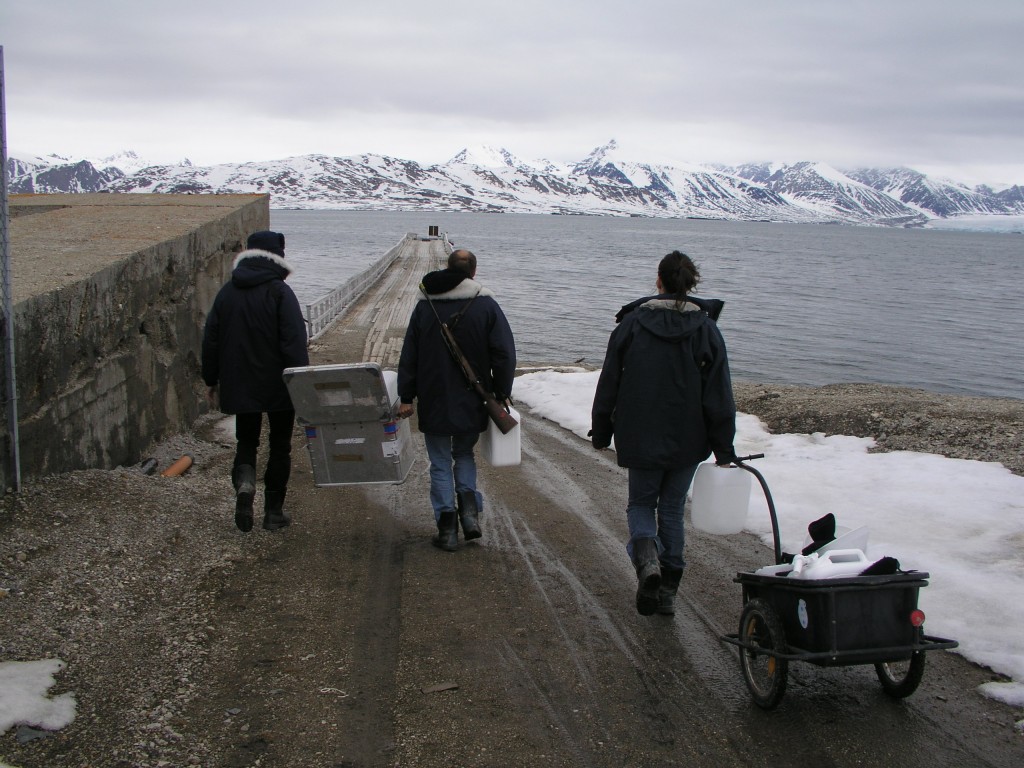
Can Arctic marine biologists work fast enough to keep up with climate change? (Ny Alesund, Pic: I.Quaile)
As with so many aspects of our oceans, there is a lack of base data on how sediment from melting glaciers affects the numerous life forms on the seabed.
“It was essential to have a basis of initial data, which we could use for comparison with the changes. In the Southern Ocean we began this work comparatively late,” says the study’s first author, marine ecologist Ricardo Sahade from the University of Cordoba and Argentina’s National Scientific and Technical Research Council CONICET, who is leading the benthic long-term series. “Combining this series of observations, accompanying ecological research on important Antarctic species, and mathematical modelling allows us to forecast the changes to the ecosystem in future scenarios,” says co-author Fernando Momo from Argentina’s National University of General Sarmiento.
With scientists telling us the ice of the West Antarctic peninsula has already passed a tipping point, the question is whether scientific monitoring and research will be able to keep pace with the rapid rate at which climate warming is already having major impacts on our oceans. For many species of our seabottom-dwelling creatures, the slow pace of greenhouse gas emissions reductions may well come far too late.
See also: Antarctic glaciers retreat unstoppable
A good haul for polar night team
The Polar Night cruise will come to an end on Tuesday, when the last of the scientists will leave the ship with their samples. I was able to stay until the end of the week, when I left the ship at Ny Alesund with some of the researchers, who were changing places with colleagues. I have left Svalbard, but not the Arctic. More about my current whereabouts later.
A good haul in the polar night
It was interesting to hear that our scientists were happy with their “catch”. Sören Häfke, the German scientist from the Alfred Wegener Institute in Bremerhaven, had more than enough of the little crustaceans calanus finmarchius. When they get back to Germany, they can start their genetic analysis to find how their biological clock works in the dark, Arctic winter. In summer, it is assumed light tells them when to come to the surface to feed and when to go down deeper to avoid predators. But what happens in winter, when it is dark all day long? I will look forward to hearing what they find out.
The Russian team had plenty of interesting sediment samples to look into. The others on board also seemed to be happy with the plankton, crustaceans and small fish they brought in for further research. Marine Cusa was a bit unhappy about the lack of polar cod in the fjord. There seemed to be no shortage of larger Atlantic cod. This is related to the amount of Atlantic water currently present in the fjord, expedition leader Stig Falk-Petersen explained to me. It looks as if Marine will be changing the subject of her Master’s thesis. But I have the feeling it will be no less interesting.
“Life doesn’t stop when the light goes out”
Paul Renaud, a Professor at the University Centre in Svalbard, coordinated the logistics of the expedition on board as well as conducting his own biological research. He is one of those who came up with this Polar Night project. As he sums it up, there is a need to follow up on the few studies done in the last ten years which indicate that there is much more activity in the Arctic ocean in winter than previously thought. This must be triggered by processes other than light. Light is critical for the functioning of the ecosystem, but “it’s not that when the light goes out, everything stops functioning”, Paul told me.
From the samples I was shown under the microscope, I can confirm that there is indeed plenty of life going on. And many of the creatures were carrying eggs.
Climate paradox: easier access – shifting parameters
I asked Paul what was driving the surge of research into the Arctic winter. Firstly, new technology makes it possible to take measurements under the ice, and all year round, when there is no-one up here, he explains. Buoys tethered to the ice are one example. A series of permanent observatories has also been set up in the fjords here, measuring temperature, salinity, oxygen, light, chlorophyll and the movement of plankton. The number of research stations in the region has also increased.
The other major factor is quite clearly climate change. The absence of ice makes it much easier to sail up here, says Paul. Just 20 years ago, this fjord would have been completely covered with ice at this time. Now the sea ice is only found in the far reaches of the fjord. But Paul confirmed my theory that while warming is making access easier, it is also changing the parameters the scientists want to measure. “We are addressing a moving target”, is how he describes it.
Ice, less ice, no ice?
When it comes to forecasting how the Arctic ocean and its ecosystem will react to climate change in the long term, the scientists here say we desperately need more data. The IPCC gives around ten scenarios for how climate in the Arctic could develop, Paul explains. Clearly, if we can rely on predictions that the Arctic will be ice-free in summer from the middle of the century at the latest, that will have certain effects on ecosystems
Some organisms can be very flexible, says Renaud, not breeding for ten years and still continuing their populations. But short-lived organisms that rely on a certain timing of ice or live in the sea ice may well be more seriously affected. But without more information, it is impossible to tell how they will react in the long term.
Along with climate change, increased development is bringing more changes to this once inaccessible region, as discussed many times here on the Ice Blog and in my articles for dw.de. Paul is involved in developing monitoring practices. He stresses this is new territory for economic activities like oil exploration, fisheries, tourism and shipping, and that we urgently need more data on the effect of these activities on sensitive components of the Arctic ecosystems.
Can science keep pace with development?
One question I seek the answer to when I talk to Arctic experts is: can this research keep pace with the speed of the development? The answer depends partly, of course, on how fast that development will be. The Svalbard expert says there will still be sea ice in the Arctic in winter for the foreseeable future, around 100-150 years. That will slow economic activities like oil and gas exploration. “That buys us a little more time”, says the marine biologist. But he sees a huge challenge to identify and monitor the impacts of rapidly growing activities like tourism and shipping.
As I packed up to prepare to leave the Helmer Hanssen at the Ny Alesund research station, Paul was giving his instructions to the scientific team. Some were leaving with me, others staying on for the next section. Coordinating the cleaning of the laboratory and deck areas still well splattered with mud, then the packing up and labeling of the samples and equipment, is a major operation. I thought it better not to whinge about fitting my cameras, recorders and Arctic gear into their bags, which somehow seemed to have shrunk over the past week.
On our last night in dock at Ny Alesund, we were treated (not for the first time this week) to some northern lights, eerily dancing across the black Arctic sky. A wicked wind bit at our faces as we headed once again for the world’s northernmost marine lab. The researchers brought crates of samples. I myself brought a treasure trove of stories, ready to go online. The Arctic in winter is harsh but has a charm of its own. It was fascinating to experience the Polar Night, but I was looking forward to my next Arctic destination a bit further south, venue for the major Arctic conference: Arctic Frontiers.
I am now in Tromso, Norway’s “Arctic capital”, where the sun will be reappearing above the horizon this week and the magic pink, pale blue, silvery grey and white Arctic light is already in evidence for several hours a day.
UN expert: Santa on Arctic watch
As we come to the end of what looks set to be one of the warmest years on record, there is plenty of reason to be concerned about the impact on the Arctic. Traditionally, in my home regions of the world in Germany and in Scotland, a lot of people look up to the snowy north with Santa Claus and the reindeer hopefully just around the corner. Here in Bonn, I recently hosted the latest edition of Deutsche Welle’s environment radio show Living Planet. One of my interview guests was Bradnee Chambers, the Executive Secretary of the UN Convention on Migratory Species, CMS, also known as the Bonn Convention. Towards the end of the interview, looking back over the wildlife year, I asked Bradnee how things were looking for the species that live up in Santa’s home, the High North, either all year round or just for some parts of the year. This is what he told me:
“We recently had our Arctic congress in Trondheim, Norway, and a report was released on Arctic biodiversity. It’s showing a lot of issues. Polar bears are being affected by a decrease in sea ice, and the report says in the next few decades we can expect a decline of over 35 percent in polar bears, we’re seeing a decline in the wetland systems up there, 50 percent of the wetlands have disappeared in the last decade in the Arctic. We’re seeing species like the ivory gull being affected. With the decline in the ice coverage in the Arctic we’re also going to see a lot more development, a lot more drilling, and this is going to affect the pristine Arctic waters that have been pretty much left untouched from development. And I’m afraid in general we are going to see a lot more impacts, as we see the Arctic change and transportation routes open up”.
Iceblogger: Will Santa still find his own transportation route on his sleigh down to us this Christmas?
Yes, I’m sure Santa will still find his way down from the Arctic to bring lots of happiness to all the children around the world. But I’m sure he’s watching out at the same time to see that the place where he lives is not going to be degraded or decline any further than it has in the last few decades!
Here’s hoping Santa will have plenty of helpers with that mammoth task in the coming year.
Happy Christmas to all Ice Blog readers, enjoy your end of year break.
I will be backafter the holiday, as I prepare for a trip to Arctic Svalbard in January. More soon. Here is a Svalbard pic to keep you going in the meantime and, I hope, make you look forward to some icy blog posts to come, as you “chill” away the festive season!
Arctic birds breeding earlier
Migratory birds that breed in the Arctic are starting to nest earlier in spring because the snow melt is occurring earlier in the season. This is confirmed by a new collaborative study,”Phenological advancement in arctic bird species: relative importance of snow melt and ecological factors” published in the current online edition of the journal Polar Biology. The scientists, including Wildlife Conservation Society (WCS) biologists, looked at the nests of four shorebird species and one songbird in Alaska, recording when the first eggs were laid in the nests. The work was undertaken across four sites ranging from the oilfields of Prudhoe bay to the remote National Petroleum Reserve of western Arctic Alaska.
The scientists looked at nesting plots at different intervals in the early spring. Other variables, like the abundance of nest predators (which is thought to affect the timing of breeding) and satellite measurements of “greenup” (the seasonal flush of the new growth of vegetation) in the tundra were also assessed as potential drivers, but were found to be less important than snow melt.
Lead author Joe Liebezeit from the Audubon Society of Portland says “it seems clear that the timing of the snow melt in Arctic Alaska is the most important mechanism driving the earlier and earlier breeding dates we observed in the Arctic. The rates of advancement in earlier breeding are higher in Arctic birds than in other temperate bird species, and this accords with the fact that the Arctic climate is changing at twice the rate.”
Over nine years, the birds advanced their nesting by an average of 4-7 days. The researcher says this fits with the general observation of 0.5 days per year observed in other studies of nest initiation in the Arctic, of which, they say, there are not very many. The rates of change are much higher than those of observed in studies of temperate birds south of the Arctic.
Co-author Steve Zack from WCS says “Migratory birds are nesting earlier in the changing Arctic, presumably to track the earlier springs and abundance of insect prey. Many of these birds winter in the tropics and might be compromising their complicated calendar of movements to accommodate this change. We’re concerned that there will be a threshold where they will no longer be able to track the emergence of these earlier springs which may impact breeding success or even population viability”.
WCS Beringia Program Coordinator Martin Robards says “Everything is a moving target in the Arctic because of the changing climate. Studies like these are valuable in helping us understand how wildlife is responding to the dramatic changes in the Arctic ecosystem. The Arctic is so dramatically shaped by ice, and it is impressive how these long-distance migrants are breeding in response to the changes in the timing of melting ice.”
In connection with Migratory Bird Day some time ago, I talked to Ferdinand Spina, head of Science at Italy’s National Institute for Wildlife Protection and Research ISPRA, in Bologna, Italy. He is also in charge of the Italian bird ringing centre, and Chair of the Scientific Council of the UN Convention on Migratory Species, CMS. In the interview, he stressed that climate change is becoming one of the greatest threats to birds that breed in the Arctic.
“Birds are a very important component of wildlife in the Arctic. There are different species breeding in the Arctic. The Arctic is subject to huge risks due to global warming. It is crucially important that we conserve such a unique ecosystem in the world. Birds have adapted to living in the Arctic over millions of years of evolution, and it’s a unique physiological and feeding adaptation. And it is our duty to conserve the Arctic as one of the few if not the only ecosystems which is still relatively intact in the world. This is a major duty we have from all possible perspectives, including an ethical and moral duty, ” he says. We talked about the seasonal mismatch, when birds arrive too early or too late to find the insects they expect to encounter and need to feed their young.
This reminds me of a visit to Zackenberg station in eastern Greenland in 2009. At that time, Lars Holst Hansen, the deputy station leader, told me the long-tailed skuas were not breeding because they rely on lemmings as prey. The lemmings were scarce because of changes in the snow cover.
Jeroen Reneerkens is another regular visitor to Zackenberg, as he tracks the migration of sanderlings between Africa and Greenland. A great project and an informative website!
Morten Rasch from the Arctic Environment Dept of Aarhus University in Denmark is the coordinator of one of the most ambitious ecological monitoring programmes in the Arctic. The Greenland Environment Monitoring Programme includes 2 stations, Zackenberg, which is in the High Arctic region and Nuuk, Greenland’s capital, in the “Lower” Arctic. Hansen and other members of Rasch’s teams monitor 3,500 different parameters in a cross-disciplinary project, combining biology, geology, glaciology, all aspects of research into the fragile eco-systems of the Arctic. At that time, he told me during an interview, ten years of monitoring had already come up with worrying results:
“We have experienced that temperature is increasing, we have experienced an increasing amount of extreme flooding events in the river, we have experienced that phenology of different species at the start-up of their growing season or the appearance of different insects for instance now comes at least 14 days earlier than when we started. And for some species, even one month earlier. And that’s a lot. You have to realise the entire growing season in these areas is only 3 months. When we start up at Zackenberg in late May, or the beginning of June, the ecosystem is completely covered in snow and more or less frozen, and when we leave, in normal years – or BEFORE climate change took over – then we left around 1st September and the ecosystem actually started to freeze up. So the entire biological ecosystem only has 3 months to reproduce and so on. And in relation to that, a movement in the start of the system between 14 days and one month – that’s a lot.”
Listen to my radio feature: Changing Arctic, Changing World
I can’t write about birds and climate change in the Arctic without finishing off with a mention of George Divoky, an ornithologist whose bird-monitoring has actually turned into climate-change monitoring on Cooper Island, off the coast of Barrow, Alaska. George looks after a colony of Black Guillemots and spends his summer on the island. In recent years, he has taken to putting up bear-proof nest boxes for the birds, because polar bears increasingly come to visit, as the melting of the sea ice has reduced their hunting options. He has also observed the presence of new types of birds which die not previously come this far north.
First World Wildlife Day and the Arctic
Maybe like me you were not aware that up to now there had been NO World Wildlife Day. Sometimes I have the feeling every day on the calendar must have been designated the day of several different causes. In fact, the UN only decided in 2013 that March 3rd 2014 should be the first World Wildlife Day. As I have commented on similar occasions here on the Ice Blog, the danger of these “international day of whatever” events is that the inflation can actually detract attention. Nevertheless, these designated days can be an opportunity to focus on particular topics. World Wildlife Day is a fine chance to remind ourselves once again of the need to protect biodiversity, especially in such a key region as the Arctic, which is being affected so drastically by climate change.
The Convention on Migratory Species of Wild Animals (CMS), a UN body with its headquarters in Bonn, plays a key role in wildlife protection. Given that animals do not recognize human-designated national borders, wildlife protection has to involve international cooperation, which is what CMS does. Bradnee Chambers is the Executive Secretary of CMS. He gave me this message for the Ice Blog on World Wildlife Day, focusing on that most famous of all Arctic creatures, the polar bear :
“The Arctic is extremely fragile and changes to its ecosystem from climate change will have irreversible consequences on migratory species such as the polar bear. We must stabilize global green gas emissions before the polar bear literally loses the very ice beneath its feet.” I can only wholeheartedly agree. And what is true of the polar bear, is true of so many other species. Let me quote at length from an article Bradnee Chambers has written:
“The largest terrestrial predator on Earth is losing the ground under its feet. Polar bears used to dominate the expanse and loneliness of the Arctic, which can seem unaffected by human presence so far. However, appearances deceive. The polar bear is now a symbol if the many species whose survival is at risk because of the effects of climate change and pollution.
The antics of Knut the polar bear cub in the Berlin Zoo touched the hearts of the German public and won him fans all over the world. The polar bear might look cute and cuddly, making it a perfect icon for Coca-Cola and many other organizations that wish to use its iconic recognition value to promote their cause or product. It is, in fact, a ferocious predator that spends much of each year on the sea ice hunting and, in the process, covers distances of up to 620 miles (1,000 kilometers). But the polar bear is also a vulnerable species listed on the International Union for Conservation of Nature’s (IUCN) Red List — one that requires constant attention and sound conservation management humanity is to ensure the polar bear’s existence for future generations.
There have long been concerted, international efforts to conserve the polar bear, and the Polar Bear Agreement meeting in Moscow in December 2013 celebrated 40 years of collaboration among the five nations where polar bears exist — namely Canada, Greenland (an autonomous community that is part of Denmark), Norway, the Russian Federation and the United States. The meeting attendees agreed on a declaration promising to beef up the monitoring of these animals and the assessment of their status, and to commit to working toward developing a polar bear action plan for the next meeting of these countries in two years’ time.
Nevertheless, these countries admitted in 2009 that climate change was the main threat that needed to be tackled. Early indications from that time were that the individual conservation efforts of the five countries were beginning to bear fruit, with most polar-bear populations at least stable — with a total of 20,000 to 25,000 individuals in the wild. But all of these hard-won advances could easily be lost if Arctic ice continues to diminish.
The Convention on Migratory Species (CMS) and its Scientific Council have been examining the effects of climate change on migration for years and, in 2011, passed an unequivocal resolution — “Migratory Species Conservation in the Light of Climate Change” — identifying the polar bear as one of the species most threatened by climate change. (…)
Climate change, which is leading to reduced ice cover and the thawing of permafrost, is not the only factor having detrimental effects on polar bears. Increased economic activities, such as oil and gas exploration and exploitation, and shipping, are also taking their toll. As apex predators, polar bears are vulnerable to environmental pollutants, and post-mortems have shown dangerous levels of mercury and other toxins in the animals. These pollutants even affect newborn cubs, which ingest the poisons in their mothers’ milk. Governments have to strike a fine balance: How are they to protect a fragile environment and forsake economic opportunities while exploiting much needed natural resources and creating jobs and wealth? The choices made often make the prospects for the polar bears bleaker, with fewer places for them to hunt and build dens in which to raise their young. The CMS is a global treaty whose parties have committed to working together to conserve the hundreds of species listed on its appendices. These range from the blue whale to the monarch butterfly to gorillas, whose territories straddle the borders of the Democratic Republic of the Congo, Rwanda and Uganda, and the arctic tern, which covers hundreds of thousands of kilometers in a lifetime in its pole-to-pole migrations. As a worldwide convention, CMS has the breadth to deal with species such as the polar bear in the context of climate change, adding a global perspective to conservation policies. The convention is used to dealing with multiple threats — such as pollution, climate change and environmental degradation — and it is recognized as the Convention on Biological Diversity’s lead partner on the conservation and sustainable use of migratory species. It has a catalog of more than 30 years’ worth of wide-ranging policies and a track record of fostering international cooperation.
At the International Forum on the Conservation of Polar Bears — which was held in December and attracted high-level participation, including from Russian Environment Minister Sergei Donskoi and his Canadian counterpart, Leona Aglukkaq — delegates were confronted with a disturbing prediction: The polar-bear population could fall by as much as two-thirds by 2050. Nations need to take action now, and the bears need all the friends they can get. CMS is ready to play its part if its parties agree to include the polar bear under its appendices.”
Bradnee Chambers’ article is available in full on LiveScience.
In a video message to mark World Wildlife Day, UNEP chief Achim Steiner says wildlife is too often thought of as a threat to development. He stresses that it is not just the big iconic animals we need to worry about. He stresses how biodiversity is essential to support life on earth. This biodiversity is under threat from climate change and pollution all round the globe – and especially in the rapidly changing and developing Arctic.



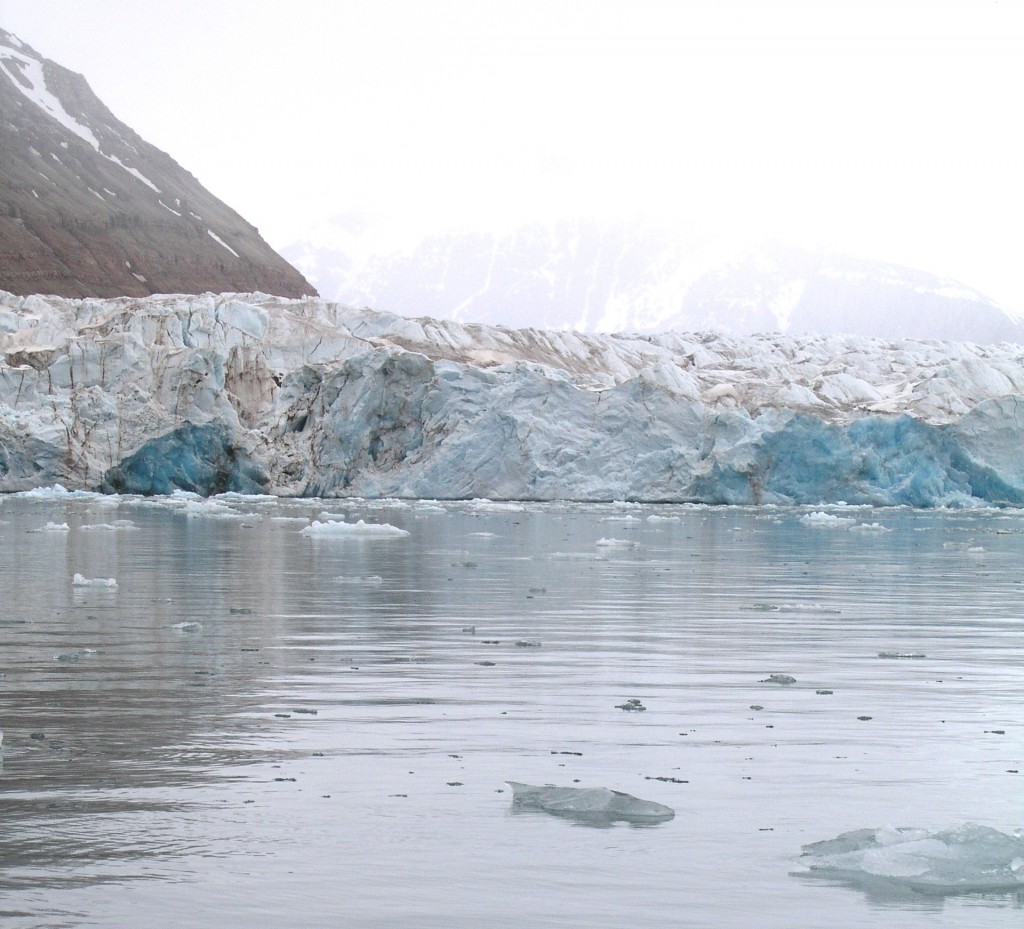
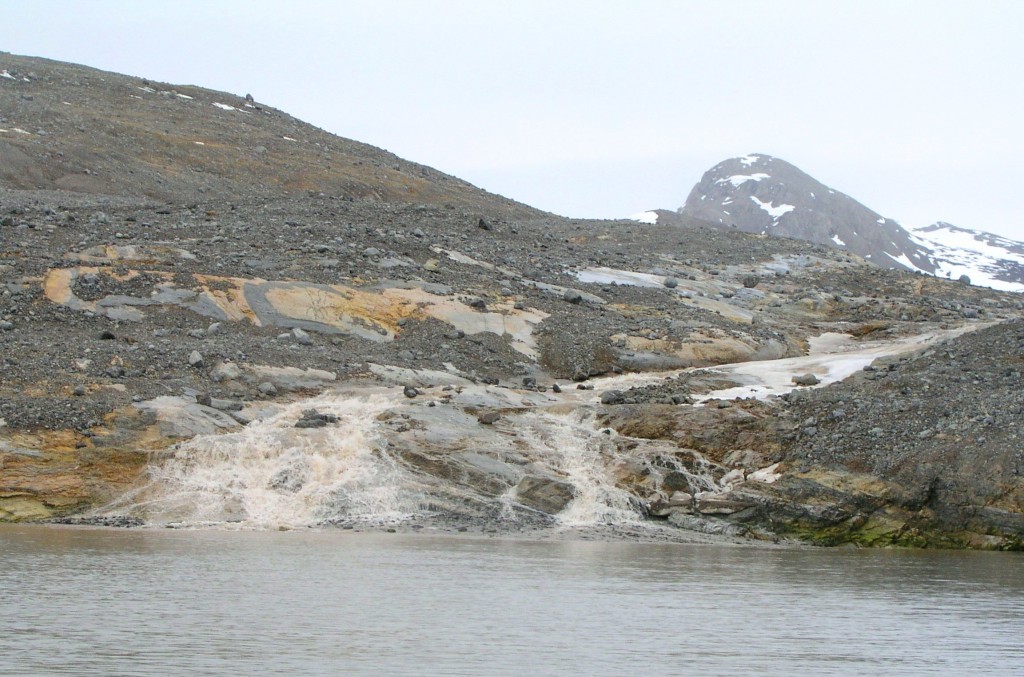





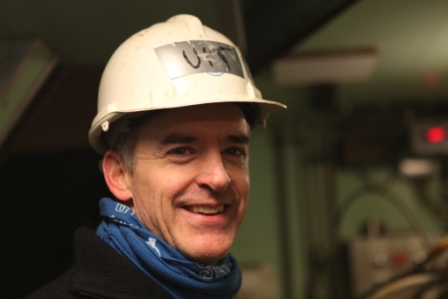
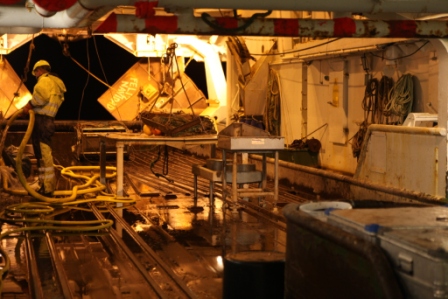

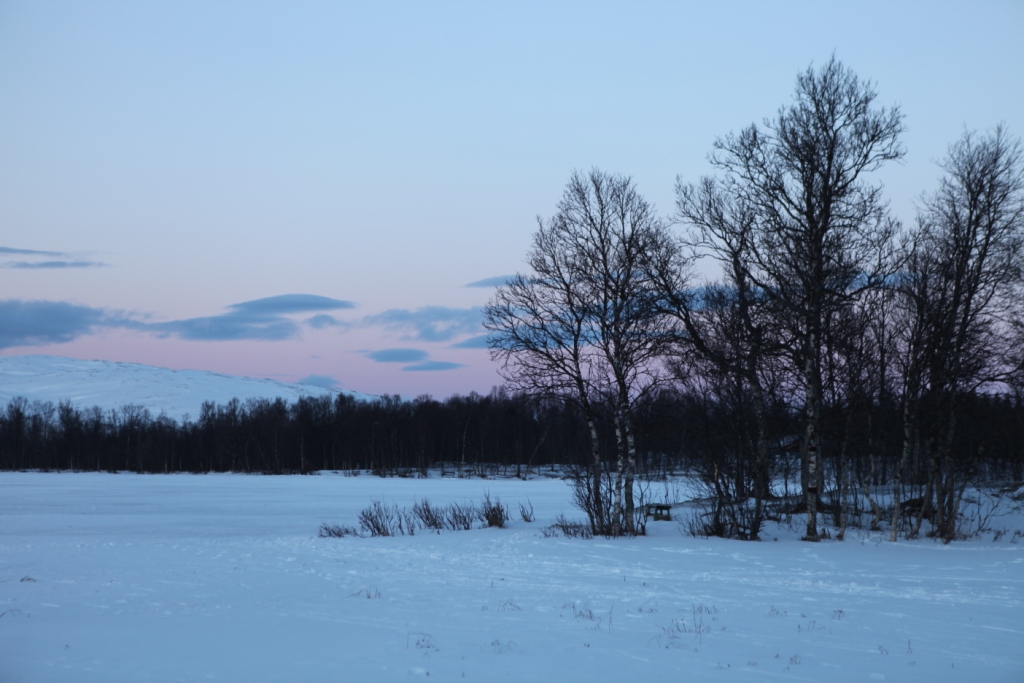
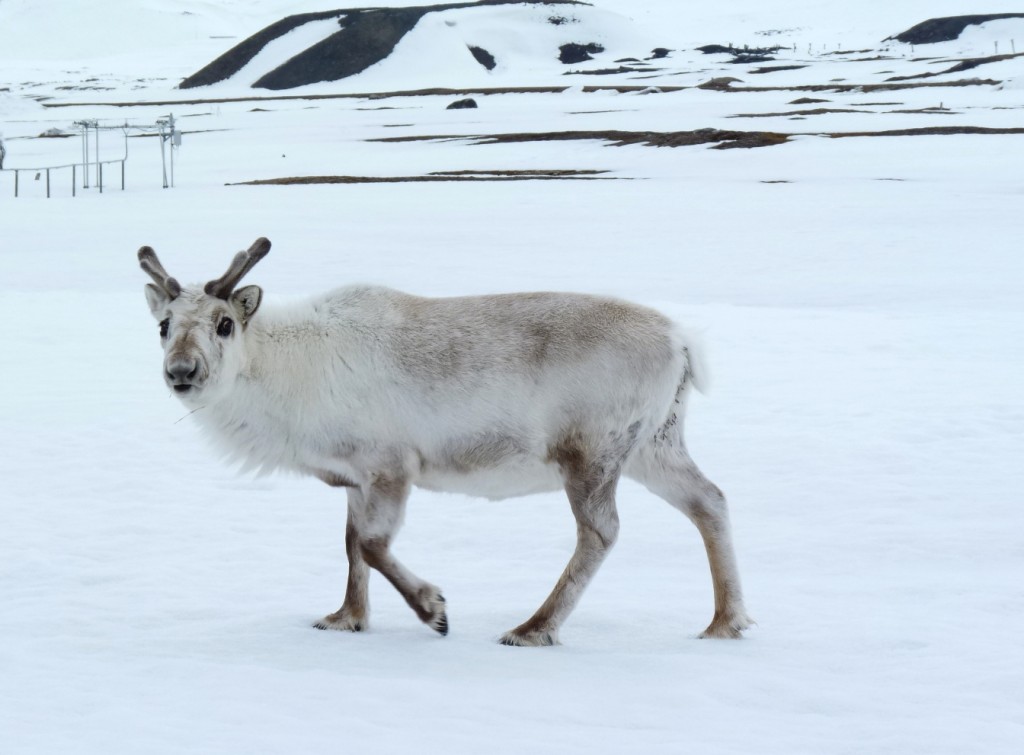



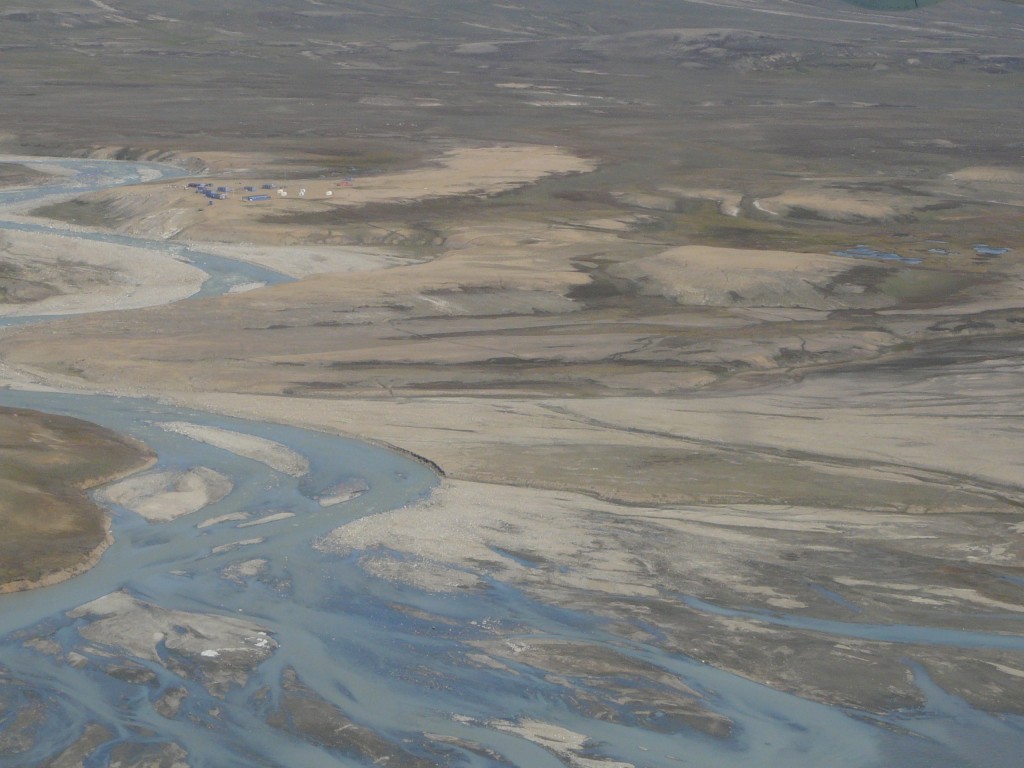
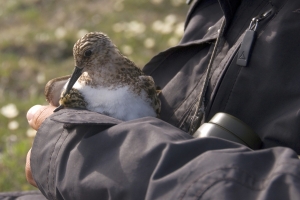
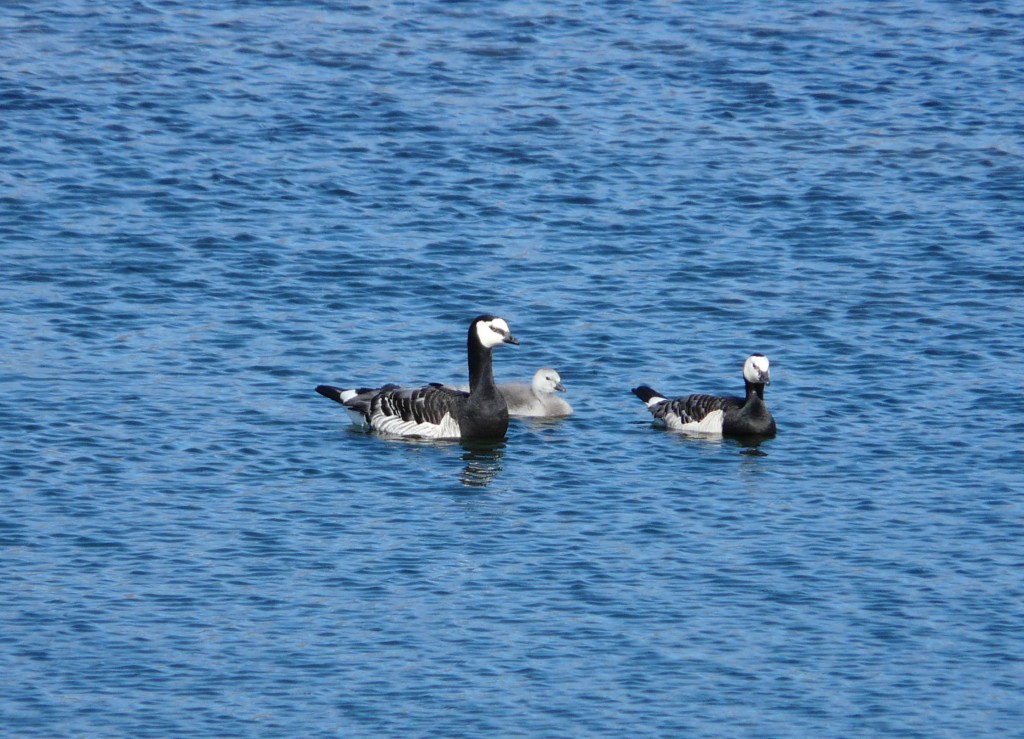

















Feedback